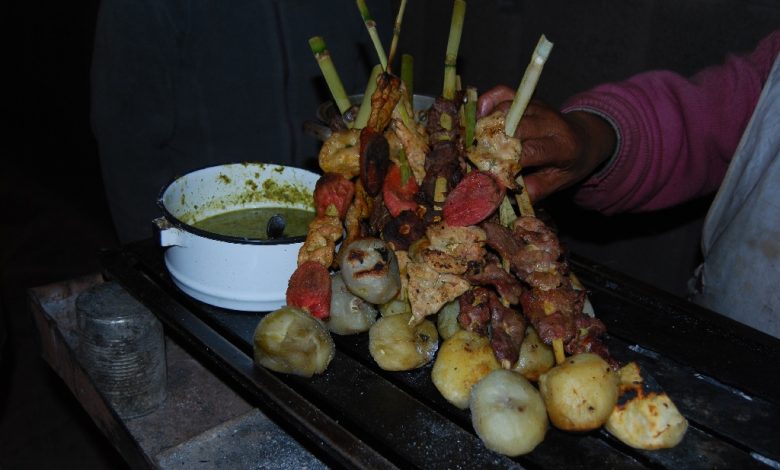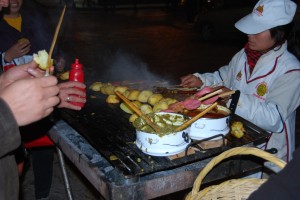Skewered Meat and Embedded Meaning, Anticuchos

As dusk falls, Maruri street fills with the smells of grilling meat just as traffic is at its densest. Portable grills appear on the sidewalk, a block from the Plaza de Armas, and are covered with skewers of sizzling meat, while knots of passersby stop, blocking traffic, to eat piece by piece the meat from the sticks.
Called anticuchos — a word that is very Peruvian, though found throughout South America — this meat on a stick joins traditions from the Middle East and Spain with those indigenous to the Incas and Pre-Inca civilizations in the Andes. Often the word is broken down as either being a combination of anti + q + uchu or as anti + cuchu.
The first would be equivalent to speaking of food belonging to the region of Anti, from which comes our modern word Andes (uchu means hot peppers literally but in Inca times came to stand for food more generally as something seasoned) while the second would refer to something sliced or cut that is Andean.
In either case, the word picks up something very important. It makes this street food found throughout Peru, and neighboring countries, paradigmatic of Andean food in general, as if nothing were more primordially Andean than stopping by a grill on wheels in the dark as the smell of flame roasted meat pulls at you to tear into juicy chunks of flesh one by one that you pull off the skeletal stick.
But, the history of how this happened is opaque. Antisuyo, or the land of Anti was one of the four quarters that made up the Inca Empire along with the land of the Collas, the Chinchas, and the Kunti. It was the north eastern slopes of the Andes where they dropped down from high, often glaciated mountains to the steaming jungles below.

The people of the Anti region are often represented in dances performed on Cuzco’s plaza in a kind of remembering and stereotyping. Young men, especially, strip down to a loin cloth, paint their chest and faces, and dance into the plaza with feathers on their heads.
In the contrast with the elaborate costumes of colored cloth with detailed masks that clothe the performers of most feast dances the ch’unchu as it is called makes a powerful contrast.
The power of the people of Antisuyo was picked up by Juan de Betanzos, a Spaniard who married Doña Angelina, a wife of the Emperor Atahuallpa and his sister. From her and her family he obtained a sort of insiders’ history of the Empire. Though written in the sixteenth century, Betanzo’s book was found and published only recently.
He writes how brave and fierce the people of the Antis were and how difficult their conquest was. The symbol he repeats over and over is that they tore the flesh from their enemies and ate it. The Inca overwhelmed them when he adopted this custom and ripped the flesh from their leader and ate it, taking his power and force inside himself.
Of course, Betanzos told this story from the perspective of the Incas. The Machiguenga or the Ashanika Indians, who are often simply called Campa, would tell events differently. They speak languages from the large family of tongues known as Arawak and inhabited the valleys and hills where Machu Picchu and Vilcabamba are located.
This is also the region where the Incas that did not accept Spanish rule sequestered themselves for decades to fight the Spanish. As a result, Antisuyo or simply Anti is a very significant area whose name has become used for the entire range of mountains and a symbol for all of Peru, and the spine of countries up and down the length of South America.
How the name anti became attached to the skewers of meat is unknown. But the name is meaningful since the Spanish also came with a tradition of skewered meat. Often called pinchos in northern Spain. Although pork–the non-Muslim meat par excellence– is the flesh on the sticks, marinated and grilled over a flame, these regions (such as Aragon) are beef growing regions and centers of Christian Spain.

This latter is meaningful, because the other tradition of skewered meat probably came to Spain with the Muslim Moors. It is the broad tradition of kebabs, now spreading in city after city around the Western world and found even in Mexico in its tacos arabes or its tacos de al pastor.
But, in Peru, though the Spanish tradition of pork stimulated an important street food (chicharrón), the iconic anticucho not only did not bring its name from Spain, it changed flesh. The iconic Spanish animal, the cow became the sacrifice for flesh. Significantly, it generally is not any part of the flesh, like the broad and tender muscles of the loin, that are skewered, but the heart and secondarily the intestines. Though other meats are used today, such as chicken or sausage, the beef heart remains the main meat served.
Peruvian writers insist the African slaves made this change, since the loins were consumed in the big house by the Spaniards. Africans are often attributed in Peru as those who taught the indigenous people Spanish ways and gave them Spanish animals.
But there may well be more here. It is as if the Peruvians were eating the hearts and guts of their enemies, the Spanish–also portrayed in satirical dances–since they eat the heart and soul of the animal that is the Spaniard’s symbol, just as the Inca in the conquest of Antisuyo ate the flesh of his enemies.
While not a victory in war, it is a symbolic victory in gastronomy when the conquerors’ symbol’s key parts get cooked, renamed, and eaten by the vanquished. It means something that these skewers found as night falls all over Peru, and especially in Cusco, are called the “food that belongs to the Andes”, or anticucho.
So, when someone lifts a fragrant skewer of meat with a potato stuck on the end to their lips they are raising something whose very name encompasses lots of history even if they are not consciously aware of it at the moment. Like much food, it means so much more than simply something nourishing to keep the body going.
And, in Cuzco it means even more. It is the paradigmatic food for eating in the street and is strongly associated, as a result, with rituals and feasts when the population takes to the streets to claim them and perform the symbols and rituals of their city and their culture.





